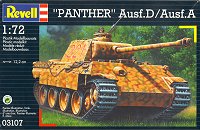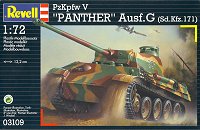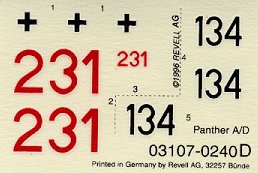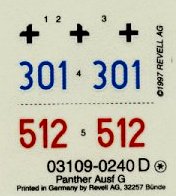

PzKpfw V Panther
Manufacturer: Revell AG.


These two kits seem to be transitional between the earlier, not-so-great Revell kits, such as the Sherman and Stug. IV, and the later, spectacular kits, such as the PzKpfw III and IV. While they are light years ahead of the Hasegawa Panther kit, they still have some minor flaws, and in fact, the out-of-production ESCI Panther A rivals this new Ausf. A kit, even though the ESCI kit was produced about 20 years prior to the Revell kit.
The two Revell kits share most of the same parts. The turret, lower hull, wheels and tracks are the same in both kits; each has a single sprue of unique parts, including the upper hull and other details.
This is the first sprue, which includes the turret and wheels. The turret is a little plain compared to the ESCI turret, with a very smooth surface, and none of the small details present on the ESCI kit, such as spare track brackets for the Ausf. A, etc. Also missing are the smoke launchers, pistol ports and communication access hatch for the Ausf. D. The periscope cover for the Ausf. G is included on a later sprue. Both styles of cupola are present, for either the early or late versions of the Panther. The late style cupola is missing a periscope; there should be seven instead of six (thanks to Niko Aposalo for reminding me of this).
The wheels have generated differing opinions between modelers; most feel that they are very well done, highly detailed, and better than either the Hasegawa and ESCI efforts. But the bolt-counters don't like them because, well ... they don't have an accurate number of bolts. Early Ausf. D's had wheels with 16 bolts. Late D's and later versions had 24-bolt wheels. These kits have 20 bolts on theirs. I know that I have been labeled as bolt-counter in the past, but to be honest, I don't really care about this particular flaw. A missing hatch on the side of the turret is one thing ... but the number of bolts on a wheel? Nah. Doesn't bother me a bit.
The next sprue contains the lower hull, chassis parts and pioneer tools. Take note on how the wheels are attached. The axles are on a backing plate separate from the lower hull, so the modeler can paint and assemble the wheels and tracks prior to attaching them to the hull. This is a very nice feature, and I can attest to the benefits of this particular design. The gun barrel is nice and straight, and the spare track links are useable too. The pioneer tools are only slightly better than being molded onto the hull, and best replaced.
Same sprue from the other side. Notice the grooves along the edge of the overhangs of the lower hull. These need to be cut through for the Ausf. G in order to fit inside the upper hull.
I feel that the tracks are very well done and they look very good on the completed model. But they are a bit larger than the real things, which is also reflected in the fact that the sprocket wheels thus have fewer teeth than they should. I imagine this was because of Revell's desire to not mold anything more delicate than the tracks are, but I think that molding finesse shown in their later releases have proven this to be a poor decision. (Two track sprues are shown in the scan, but only one is included in each kit.) Here is a close-up of the track detail:

This is the sprue included with the Panther D/A kit. Two types of exhaust pipes are included, the single pipes for the Ausf. D, and the triple left-side pipe for the Ausf. A. Also shown is the flap cover for the hull machine gun on the Ausf. D. The ball mount cover for the Ausf. A and G is included on another sprue. The hull details are very well done, with outstanding relief to the hinges, handles and panels. One interesting oversight though: the circular cooling exhaust grills are not correct. There is a spiral pattern to the framework in the grills (which is actually spiralling in the wrong direction) which was only seen on the Ausf. D. The grills on the Ausf. A did not have the spiral pattern; instead the frames radiated straight outward from the center. The handles on the driver's and radio operator's hatches need to be relocated to the center of the hatches for the Ausf. D. One area where the ESCI Panther beats this kit is the shape of the hull sides. The notched area towards the rear of the hull is shaped incorrectly on this kit, and looks much better on the ESCI kit.
This is the sprue included with the Panther G kit. Notice all the options given: the different styles of gun mantlet, the different exhaust pipes, and the raised cooling exhaust vent for the left side. Although these options give the modeler many choices, I think that the lack of steel wheels was a major oversight. If you feel like spending the extra money for a Hasegawa Late Panther kit, the steel wheels in that kit are pretty good, and with some creative surgery, can be used on the Revell kit. All in all, the Ausf. G has many fewer errors and ommisions than the Ausf. D/A kit.
The decals for the Ausf. D/A kit includes markings for one of each version: an Ausf. D on the East Front in 1944, and an Ausf. A of Panzer Lehr Division, Saint Lo, 1944.

The Panther G kit includes markings for two unknown units, one on the West Front in 1945, and another on the East Front in 1945.

According to the dimensions in Achtung Panzer No. 4 - Panther, Jagdpanther and Brummbar, these kits scale out almost perfectly to 1/72nd. I can recommend both of these kits whole-heartedly, especially the Ausf. G. Brass detail sets are available from Eduard, ExtraTech and PART, including several patterns of zimmerit coating from PART, and all of these sets will go a long way in improving the kits, especially the D/A.
| Back to Revell AG. Kit List | Back to Home Page |